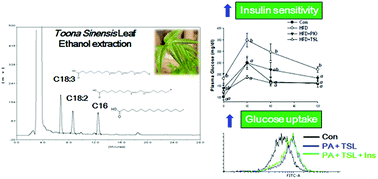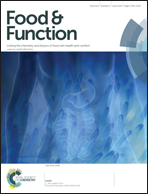Toona Sinensis ameliorates insulin resistance via AMPK and PPARγ pathways†
Abstract
Toona Sinensis leaf (TSL) extract with a beneficial effect for managing hyperglycemia has been reported, however the underlying mechanism by which TSL extract acts as an insulin sensitizer remains uncertain, especially in peripheral tissues. TSL 95% ethanol extract exhibited the highest transactivity of PPARγ and contained the highest amounts of natural PPARγ ligands including palmitic acid, linoleic acid, and α-linolenic acid among different TSL ethanol extracts (0, 10, 50, 70, and 95%). The efficacy and the mechanism of TSL ethanol extract (95%) mediated anti-diabetic effects were examined by both in vivo and in vitro models in this study. An improved whole-body insulin sensitivity was observed in high-fat diet-fed (HFD) mice after 14 weeks of TSL treatment, as evidenced by a faster rate of plasma glucose clearing. The improved insulin sensitivity was through direct stimulation of PPARγ and adiponectin expression in adipose tissues of HFD mice. In addition to the PPARγ pathway, TSL stimulated glucose uptake via directly inducing AMPKα but not AS160 activation in C2C12 myotubes under palmitate-induced insulin resistance. TSL successfully induced sirtuin 1 and restored PGC1α, but failed to restore mitochondrial electron transport complexes I, III, IV and V in mRNA levels. Loss of the mitochondrial membrane potential coupled with AMPK activation suggests that TSL acts as a mitochondrial inhibitor to stimulate AMPK-mediated glucose uptake. This study demonstrated that TSL stimulated glucose uptake via AMPK activation in skeletal muscles and promoted PPARγ and normalized adiponectin expression in adipose tissues, thereby ameliorating insulin resistance.


 Please wait while we load your content...
Please wait while we load your content...